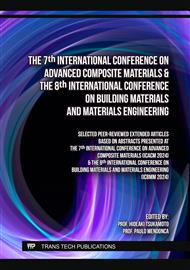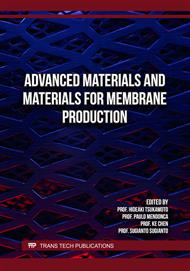[1]
I. Capasso, B. Liguori, C. Ferone, D. Caputo, R. Cioffi, Strategies for the valorization of soil waste by geopolymer production: An overview, J Clean Prod 288 (2021) 125646.
DOI: 10.1016/j.jclepro.2020.125646
Google Scholar
[2]
C.K. Purchase, D.M. Al Zulayq, B.T. O'Brien, M.J. Kowalewski, A. Berenjian, A.H. Tarighaleslami, M. Seifan, Circular Economy of Construction and Demolition Waste: A Literature Review on Lessons, Challenges, and Benefits, Materials 15 (2021) 76.
DOI: 10.3390/ma15010076
Google Scholar
[3]
N. Islam, M. Sandanayake, S. Muthukumaran, D. Navaratna, Review on Sustainable Construction and Demolition Waste Management—Challenges and Research Prospects, Sustainability 16 (2024) 3289.
DOI: 10.3390/su16083289
Google Scholar
[4]
D.R. Rondinel-Oviedo, Construction and demolition waste management in developing countries: a diagnosis from 265 construction sites in the Lima Metropolitan Area, International Journal of Construction Management 23 (2023) 371–382. https://doi.org/10.1080/15623599. 2021.1874677.
DOI: 10.1080/15623599.2021.1874677
Google Scholar
[5]
D. Cheng, D.M. Reiner, F. Yang, C. Cui, J. Meng, Y. Shan, Y. Liu, S. Tao, D. Guan, Projecting future carbon emissions from cement production in developing countries, Nat Commun 14 (2023) 8213.
DOI: 10.1038/s41467-023-43660-x
Google Scholar
[6]
P. Pradhan, S. Dwibedy, M. Pradhan, S. Panda, S.K. Panigrahi, Durability characteristics of geopolymer concrete - Progress and perspectives, Journal of Building Engineering 59 (2022) 105100.
DOI: 10.1016/j.jobe.2022.105100
Google Scholar
[7]
S. Sperinck, P. Raiteri, N. Marks, K. Wright, Dehydroxylation of kaolinite to metakaolin—a molecular dynamics study, J. Mater. Chem. 21 (2011) 2118–2125.
DOI: 10.1039/C0JM01748E
Google Scholar
[8]
F. Cassagnabère, P. Diederich, M. Mouret, G. Escadeillas, M. Lachemi, Impact of metakaolin characteristics on the rheological properties of mortar in the fresh state, Cem Concr Compos 37 (2013) 95–107.
DOI: 10.1016/j.cemconcomp.2012.12.001
Google Scholar
[9]
R.T. Lermen, E.M. Korf, L.N. de Oliveira, R.N. de Oliveira, D.D. dos Santos Neto, R. Ferreira Júnior, R.A. Silva, Evaluation of the properties of a foamed geopolymer developed with different types of metakaolin, Ceramica 67 (2021) 164–178.
DOI: 10.1590/0366-69132021673823004
Google Scholar
[10]
A.M. Menshaz, M.A.M. Johari, Z.A. Ahmad, Characterization of metakaolin treated at different calcination temperatures, in: 2017: p.020028.
DOI: 10.1063/1.5005659
Google Scholar
[11]
F.A. Huamán-Mamani, C.K. Palomino-Ñaupa, M. del M. Orta Cuevas, S. Medina-Carrasco, Fabrication and Mechanical Evaluation of Eco-Friendly Geopolymeric Mortars Derived from Ignimbrite and Demolition Waste from the Construction Industry in Peru, Geosciences (Basel) 14 (2024) 80.
DOI: 10.3390/geosciences14030080
Google Scholar
[12]
H. Wang, H. Li, Y. Wang, F. Yan, Preparation of macroporous ceramic from metakaolinite-based geopolymer by calcination, Ceram Int 41 (2015) 11177–11183.
DOI: 10.1016/j.ceramint.2015.05.067
Google Scholar
[13]
S. Andrejkovičová, A. Sudagar, J. Rocha, C. Patinha, W. Hajjaji, E.F. da Silva, A. Velosa, F. Rocha, The effect of natural zeolite on microstructure, mechanical and heavy metals adsorption properties of metakaolin based geopolymers, Appl Clay Sci 126 (2016) 141–152.
DOI: 10.1016/j.clay.2016.03.009
Google Scholar
[14]
E. B, C. Z, Synthesis and Characterization of Polyaniline/Ignimbrite Nano-Composite Material, Journal of Material Science & Engineering 05 (2016).
DOI: 10.4172/2169-0022.1000237
Google Scholar
[15]
P. Rovnaník, Effect of curing temperature on the development of hard structure of metakaolin-based geopolymer, Constr Build Mater 24 (2010) 1176–1183. https://doi.org/.
DOI: 10.1016/j.conbuildmat.2009.12.023
Google Scholar
[16]
J.L. Provis, S.L. Yong, J.S.J. van Deventer, Characterising the Reaction of Metakaolin in an Alkaline Environment by XPS, and Time- and Spatially-Resolved FTIR Spectroscopy, in: 2015: p.299–304.
DOI: 10.1007/978-94-017-9939-3_37
Google Scholar
[17]
R. Dewi, H. Agusnar, Z. Alfian, Tamrin, Characterization of technical kaolin using XRF, SEM, XRD, FTIR and its potentials as industrial raw materials, J Phys Conf Ser 1116 (2018) 042010.
DOI: 10.1088/1742-6596/1116/4/042010
Google Scholar
[18]
C.T. Johnston, J.E. Kogel, D.L. Bish, T. Kogure, H.H. Murray, Low-temperature FTIR study of kaolin-group minerals, Clays Clay Miner 56 (2008) 470–485.
DOI: 10.1346/CCMN.2008.0560408
Google Scholar
[19]
S. Kumar, A.K. Panda, R.K. Singh, Preparation and Characterization of Acid and Alkaline Treated Kaolin Clay, Bulletin of Chemical Reaction Engineering & Catalysis 8 (2013) 61–69.
DOI: 10.9767/bcrec.8.1.4530.61-69
Google Scholar
[20]
A.G. de S. Azevedo, K. Strecker, C.T. Lombardi, Produção de geopolímeros à base de metacaulim e cerâmica vermelha, Cerâmica 64 (2018).
DOI: 10.1590/0366-69132018643712420
Google Scholar
[21]
O. Mahmoodi, H. Siad, M. Lachemi, M. Sahmaran, Synthesis and optimization of binary systems of brick and concrete wastes geopolymers at ambient environment, Constr Build Mater 276 (2021) 122217.
DOI: 10.1016/j.conbuildmat.2020.122217
Google Scholar



